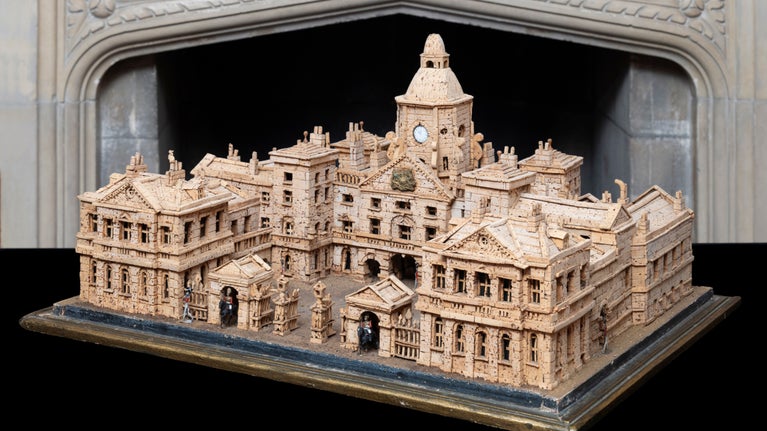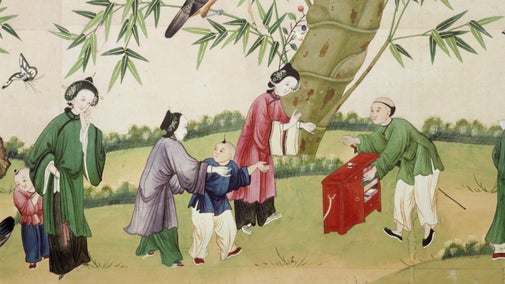
Art and collections
We care for one of the world's largest and most significant collections of art and heritage objects. Explore the highlights, our latest major exhibitions, curatorial research and more.

The National Trust looks after the largest collection of tapestries in Britain – one of the largest in the world – with around 650 items across more than 200 historic houses. Discover just a handful of examples of this outstanding craftmanship you can see up close.
For hundreds of years, tapestries were the status symbol of the wealthy across Europe, covering the walls of palaces, cathedrals and chambers, and owned by monarchs, clergy, courtiers and the very rich.
These were the great art of their day, woven in wool and silk threads and made by outstanding craftsmen with a level of aesthetic and technical skill long since lost.
Montacute is home to a small but outstanding group of late medieval tapestries bequeathed by Sir Malcolm Stewart, including the 15th-century masterpiece Knight with the Arms of Jean de Daillon. It is one of few surviving examples from the late 15th century that can be precisely identified.
It depicts a chivalric knight in full armour, his standard fluttering, his horse richly decorated in what resembles red and gold brocade.
The dark blue ground is scattered with tiny star-like flowers – a style known as millefleurs. Many of the flowers are identifiable, including poppies, daffodils, scillas, wallflowers, thistles, honeysuckle and fritillaries.
This rare and highly decorative piece was commissioned by the town of Tournai in 1477–79 as a gift to the governor of the Dauphine, Jean de Daillon, Seigneur de Laude, whose coat of arms appears in the top left corner.

At Hardwick Hall in Derbyshire, there is an internationally significant collection of tapestries – more than 100 in total – some of them still hanging as recorded in the 1601 will of Elizabeth, countess of Shrewsbury (otherwise known as Bess of Hardwick).
Although now covered with paintings, the Gideon tapestries in Hardwick's Long Gallery still define the space as they did in the 1590s. They were originally woven in 1578 for the flamboyant Elizabethan courtier, Sir Christopher Hatton, but were acquired a decade later by Bess.
Comprised of 13 separate panels, each tapestry is nearly 20 feet high and the set more than 230 feet in total length. Few tapestries could have come close to being able to fill Hardwick's 160-foot long, double-height Gallery, so it was an extraordinary stroke of luck that such an enormous set was available for Bess to purchase at the time.

The 17th-century tapestry collection at Ham House in Richmond was once rich and richly documented, providing insights into tapestry patronage at the highest level under both Charles I and Charles II. Sadly, most were sold in the 20th century before Ham House came to the National Trust.
Despite this, six identical tapestry panels, known as sumpter cloths, survive. Sumpter cloths were portable textiles, used to cover luggage and to signify the wealth and magnificence of travelling nobility from the Middle Ages onwards.
These sumpter cloths would have adorned the Duke of Lauderdale’s luggage, as his coat of arms appear at the centre of each panel. Sumpter cloths remind us that in the 17th century, tapestries were by no means immovable fixtures.

Some tapestries had clear ceremonial and diplomatic functions. A vast tapestry from 1765 depicts Tsar Peter the Great defeating the Swedish army in the battle of Poltava in 1709, a turning point in the Great Northern War between Russia and Sweden for control of the Baltic Sea. Poltava is a city in the modern country of Ukraine. The tapestry was presented to the Earl of Buckinghamshire, by the Tsar’s wife Catherine, when he was the ambassador to Russia. The Earl later installed it at Blickling Hall as a memorial to his mission.
Even before it became a very grand diplomatic gift, this tapestry played an interesting role in the Russian czar's quest to aggrandise his image as sovereign. It was Peter the Great's ambition to set up a national factory in St Petersburg to emulate, if not rival, the Manufacture des Gobelins – the royal manufactory under Louis XIV that produced tapestries for the French crown and nobility.
Following a visit to France in 1716–17, Peter brought French craftsmen to Russia to run his new workshop and train Russian apprentices in the art of weaving. The Peter the Great tapestry marked the high point in his workshop’s production.

The spectacular tapestry room at Osterley Park demonstrates the transformative power of the tapestry medium. It’s comprised of 18 separate pieces of tapestry, ranging from narrow strips just a few inches wide to large panels covering entire walls.
These hangings imitate more fashionable textiles and furnishings. The pink background is woven to create the effect of silk damask, and each roundel imitates a painting set in an oval frame, complete with a frame resembling carved and gilded wood.
The tapestries were commissioned by Robert Child from the Gobelins Manufactory in Paris. Woven in 1775, they were delivered and installed at Osterley the following year.
– Horace Walpole, 1778

During the 1920s and 1930s, the distinguished collector Lord Fairhaven assembled an excellent group of mainly 17th-century tapestries for his new home Anglesey Abbey. However, he also commissioned brand new hangings from the local Cambridge Tapestry Company, including a view of Anglesey Abbey in 1934, the first piece to be woven at the Cambridge workshop.
Designed by Clifford Barber and referencing the designs of tapestry in the past, it shows an aerial view of the Cambridgeshire landscape with Anglesey Abbey and its garden in the centre. A stream runs through a wooded landscape in the foreground and the distance landscape is dotted with Cambridgeshire landmarks like the University Library of Cambridge and Jocky Club rooms at Newmarket Racecourse. The borders are composed of leaves, fruit and flowers on a light brown ground, and the arms of Lord Fairhaven appear in the upper centre.

Many of the National Trust’s tapestries are displayed in the houses for which they were originally acquired, allowing us to trace their history, the changes in their use and the way people have appreciated them.
Learn more with this educational video on the importance of tapestries.

We care for one of the world's largest and most significant collections of art and heritage objects. Explore the highlights, our latest major exhibitions, curatorial research and more.
From goldwork and gilding to goldsmithing and jewellery making, discover the ways in which gold has been used in the objects in our collections.

We care for the largest collection of historic Chinese wallpapers on permanent public display in the world. Find out why they were popular and learn about styles through the centuries.

Discover the stories behind some of the greatest artworks and artefacts looked after by the National Trust, as told in a dedicated book, 125 Treasures from the Collections of the National Trust.
